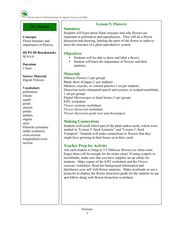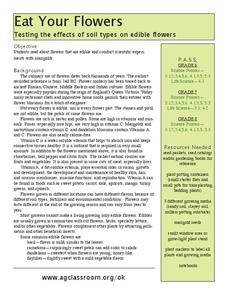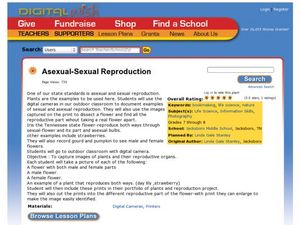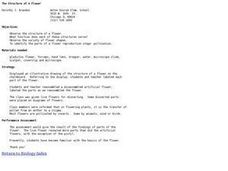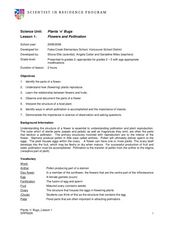Crash Course
The Sex Lives of Nonvascular Plants: Alternation of Generations
Plants evolved more than 400 million years ago into two types — vascular and nonvascular. Here's a video that explains the difference between vascular and nonvascular plants and then focuses on the over 24,000 types of nonvascular...
Curated OER
Dry Forest: Flowers
Students explore botany by examining diagrams. In this plant reproduction instructional activity, students define a list of plant vocabulary terms and identify plant anatomy from a diagram. Students complete several plant activity...
Curated OER
Flowers Galore
Students create original works of art using their knowledge of Georgia O'Keeffe's artwork, flowers, pencils, crayons, and pastels in this K-6 Art lesson plan. The lesson plan includes Georgia O'Keeffe resource links and a recommended...
Curated OER
Plant Reproduction
Fifth graders discuss the way a plant can reproduce from roots, stems, and leaves instead of the more familiar way of flowers, fruits, and seeds. In groups of four, 5th graders pick a plant group. Each group then writes a report,...
Curated OER
Eat Your Flowers
Students grow flowers in different soil mediums to determine the effect on flavor. In this investigative lesson students study flowers, plant them and taste them to see how they differ in different potting soils.
Curated OER
Asexual-Sexual Reproduction
Eighth graders examine the reproductive organs of plants. In this plant reproduction lesson, 8th graders identify the reproductive organs of different plants using a digital camera. Students create a plant portfolio of images large...
Curated OER
Bats, Bees, Birds, and Blossoms
Youngsters use a paper bee to pollinate two paper flowers. They use hole-punch dots as pollen. Older learners dissect flowers and name the structures involved in pollination. The handouts mentioned in the lesson plan are not included, so...
Curated OER
Plant Reproduction
High schoolers identify the different parts and function of a flower's reproductive system. In this biology lesson, students explain how pollination works. They watch a video and practice labeling parts of both flower and leaf.
Curated OER
The Blossoming of Flower Power
Learners explore the reproductive functions of flowers by participating in a flower dissection lab.
Curated OER
Pollination-Plants and Flowers Lesson Plan
Students study the reproductive parts and pollination for a flower. In this pollination lesson plan, students dissect flowers to perform an investigation. Students also use tube socks to show how pollination works. A diagram is included.
Curated OER
The Structure of A Flower
Students study the structure of flowers. In this biology lesson plan, students observe the structure of a flower and find out what function each of the structures serve.
Curated OER
Flowering Phenology: How Do Plants Know When to Flower?
Students study the process of plant reproduction and the biotic and abiotic factors that affect flowering phenology. In this plant reproduction lesson plan, students describe the interaction of environmental factors as it relates to...
Curated OER
From Flower to Fruit
Students examine how flowers have essentially four parts. They learn both the male and female reproductive parts of the flower, then explore self-pollination and pollination by insects and other animals.
Curated OER
Plant Reproduction
Learners investigate seeds and plant life by creating a germination chamber. For this botany lesson, students investigate the relationship between flowers and the fruit they produce while examining the structure of the flower. Learners...
Curated OER
Flowers and Pollination
Young scholars explore the environment by researching plant reproduction. In this pollination instructional activity, students define botany related vocabulary terms such as disc flower, petal and fertilization. Young scholars dissect a...
Curated OER
Flowers Galore
Learners examine the work of Georgia O'Keefe and observe the shapes and lines that make up a flower. They create a flower drawing or painting.
Curated OER
Pollinators and Wildflowers
Learners explore how plants depend on pollinators to reproduce. In this pollination lesson students dissect a local flower and collect and identify pollinating insects.
Curated OER
The Great Pollinators
Students discover the reproductive parts of a plant. In this biology lesson, students identify and categorize several different plants they dissect in class. Students record their information using a data chart.
Curated OER
Plant Pollination
Students investigate methods of pollination for various flowers. In this plant biology lesson, students learn the parts of a flower and form a hypothesis about the method of pollination for the flower. They determine the validity of...
California Academy of Science
Why Protect Pollinators?
Would you rather having biting flies or chocolate? The question may seem absurd, but cocoa trees rely on pollination from biting flies. Viewers come to understand the importance of pollinators to our food supply, flowers, and entire...
Curated OER
Mutualism and Co-evolution A study of Flowering Plants and their Pollinators: Biology, Plants
These lessons use a variety of methods and approaches to teach flowering plant biology which includes seed germination; plant growth and food production through photosynthesis; plant transpiration and respiration; sexual reproduction...
Curated OER
Fun with Plants Flower Power
Students understand the parts of the flower. In this flower lesson, students perform experiments to see where seeds come from. Students complete a data sheet about the experiment. Students understand the terms pistil and stamen.
Curated OER
Flowering Phenology: How Do Plants Know When To Flower?
Students explore the biotic and abiotic factors that affect plant reproduction and the potential consequences of human activities on plant populations. The effects of urbanization are discussed as an influence in the consequences.
Other popular searches
- Flower Reproduction Diagram
- Labs for Flower Reproduction
- Label Flower Reproduction
- Flower Reproduction Video
- Star Flower Reproduction
- Plants, Flower Reproduction
- Plants Flower Reproduction



